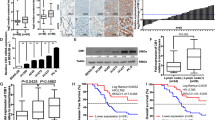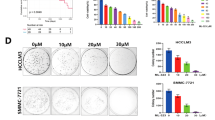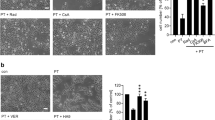Abstract
The regulation of CCAAT/enhancer-binding protein-homologous protein (CHOP), an endoplasmic reticulum (ER) stress-response factor, is key to cellular survival. Hypoxia is a physiologically important stress that induces cell death in the context of the ER, especially in solid tumors. Although our previous studies have suggested that Cyclophilin B (CypB), a molecular chaperone, has a role in ER stress, currently, there is no direct information supporting its mechanism under hypoxia. Here, we demonstrate for the first time that CypB is associated with p300 E4 ligase, induces ubiquitination and regulates the proteasomal turnover of CHOP, one of the well-known pro-apoptotic molecules under hypoxia. Our findings show that CypB physically interacts with the N-terminal α-helix domain of CHOP under hypoxia and cooperates with p300 to modulate the ubiquitination of CHOP. We also show that CypB is transcriptionally induced through ATF6 under hypoxia. Collectively, these findings demonstrate that CypB prevents hypoxia-induced cell death through modulation of ubiquitin-mediated CHOP protein degradation, suggesting that CypB may have an important role in the tight regulation of CHOP under hypoxia.
Similar content being viewed by others
Log in or create a free account to read this content
Gain free access to this article, as well as selected content from this journal and more on nature.com
or
Abbreviations
- CypB:
-
cyclophilin B
- PPIase:
-
peptidyl-prolyl cis–trans isomerase
- ER:
-
endoplasmic reticulum
- GRP:
-
glucose-regulated protein
- UPR:
-
unfolded protein response
- IRE1α:
-
inositol-requiring transmembrane kinase and endonuclease 1α
- PERK:
-
RNA-dependent protein kinase-like ER kinase
- ATF6:
-
activating transcription factor 6
- ATF4:
-
activating transcription factor 4
- eIF2α:
-
eukaryotic translation initiation factor 2α
- CHOP:
-
CCAAT/enhancer-binding protein-homologous protein
- JNK:
-
c-Jun NH2-terminal kinase
- TUNEL:
-
terminal deoxynucleotidyl transferase-mediated dUTP nick-end labeling
- CHX:
-
cycloheximide
- BCCAO:
-
bilateral common carotid arteries occlusion
References
Zinszner H, Kuroda M, Wang X, Batchvarova N, Lightfoot RT, Remotti H et al. CHOP is implicated in programmed cell death in response to impaired function of the endoplasmic reticulum. Genes Dev 1998; 12: 982–995.
McCullough KD, Martindale JL, Klotz LO, Aw TY, Holbrook NJ . Gadd153 sensitizes cells to endoplasmic reticulum stress by down-regulating Bcl2 and perturbing the cellular redox state. Mol Cell Biol 2001; 21: 1249–1259.
Luethy JD, Holbrook NJ . Activation of the gadd153 promoter by genotoxic agents: a rapid and specific response to DNA damage. Cancer Res 1992; 52: 5–10.
Wang XZ, Lawson B, Brewer JW, Zinszner H, Sanjay A, Mi LJ et al. Signals from the stressed endoplasmic reticulum induce C/EBP-homologous protein (CHOP/GADD153). Mol Cell Biol 1996; 16: 4273–4280.
Fawcett TW, Martindale JL, Guyton KZ, Hai T, Holbrook NJ . Complexes containing activating transcription factor (ATF)/cAMP-responsive-element-binding protein (CREB) interact with the CCAAT/enhancer-binding protein (C/EBP)-ATF composite site to regulate Gadd153 expression during the stress response. Biochem J 1999; 339: 135–141.
Averous J, Bruhat A, Jousse C, Carraro V, Thiel G, Fafournoux P . Induction of CHOP expression by amino acid limitation requires both ATF4 expression and ATF2 phosphorylation. J Biol Chem 2004; 279: 5288–5297.
Friedman AD . GADD153/CHOP, a DNA damage-inducible protein, reduced CAAT/enhancer binding protein activities and increased apoptosis in 32D c13 myeloid cells. Cancer Res 1996; 56: 3250–3256.
Ohoka N, Hattori T, Kitagawa M, Onozaki K, Hayashi H . Critical and functional regulation of CHOP (C/EBP homologous protein) through the N-terminal portion. J Biol Chem 2007; 282: 35687–35694.
Gupta S, Read DE, Deepti A, Cawley K, Gupta A, Oommen D et al. Perk-dependent repression of miR-106b-25 cluster is required for ER stress-induced apoptosis. Cell Death Dis 2012; 3: e333.
Kim J, Choi TG, Ding Y, Kim Y, Ha KS, Lee KH et al. Overexpressed cyclophilin B suppresses apoptosis associated with ROS and Ca2+ homeostasis after ER stress. J Cell Sci 2008; 121: 3636–3648.
Hattori T, Ohoka N, Inoue Y, Hayashi H, Onozaki K . C/EBP family transcription factors are degraded by the proteasome but stabilized by forming dimer. Oncogene 2003; 22: 1273–1280.
Ron D, Habener JF . CHOP, a novel developmentally regulated nuclear protein that dimerizes with transcription factors C/EBP and LAP and functions as a dominant-negative inhibitor of gene transcription. Genes Dev 1992; 6: 439–453.
Grossman SR, Deato ME, Brignone C, Chan HM, Kung AL, Tagami H et al. Polyubiquitination of p53 by a ubiquitin ligase activity of p300. Science 2003; 300: 342–344.
Blais JD, Filipenko V, Bi M, Harding HP, Ron D, Koumenis C et al. Activating transcription factor 4 is translationally regulated by hypoxic stress. Mol Cell Biol 2004; 24: 7469–7482.
Okada T, Haze K, Nadanaka S, Yoshida H, Seidah NG, Hirano Y et al. A serine protease inhibitor prevents endoplasmic reticulum stress-induced cleavage but not transport of the membrane-bound transcription factor ATF6. J Biol Chem 2003; 278: 31024–31032.
Kim Y, Jang M, Lim S, Won H, Yoon KS, Park JH et al. Role of cyclophilin B in tumorigenesis and cisplatin resistance in hepatocellular carcinoma in humans. Hepatology 2011; 54: 1661–1678.
Jiang BH, Semenza GL, Bauer C, Marti HH . Hypoxia-inducible factor 1 levels vary exponentially over a physiologically relevant range of O2 tension. Am J Physiol 1996; 271: C1172–C1180.
Kumar R, Azam S, Sullivan JM, Owen C, Cavener DR, Zhang P et al. Brain ischemia and reperfusion activates the eukaryotic initiation factor 2alpha kinase, PERK. J Neurochem 2001; 77: 1418–1421.
Bukau B, Horwich AL . The Hsp70 and Hsp60 chaperone machines. Cell 1998; 92: 351–366.
Frydman J . Folding of newly translated proteins in vivo: the role of molecular chaperones. Annu Rev Biochem 2001; 70: 603–647.
Young JC, Agashe VR, Siegers K, Hartl FU . Pathways of chaperone-mediated protein folding in the cytosol. Nat Rev Mol Cell Biol 2004; 5: 781–791.
Kettern N, Dreiseidler M, Tawo R, Hohfeld J . Chaperone-assisted degradation: multiple paths to destruction. Biol Chem 2010; 391: 481–489.
Wu C, Zhan RZ, Qi S, Fujihara H, Taga K, Shimoji K . A forebrain ischemic preconditioning model established in C57Black/Crj6 mice. J Neurosci Methods 2001; 107: 101–106.
Acknowledgements
This study was supported by a grant from the Korean Health Technology R&D Project, Ministry of Health, Welfare, and Family Affairs, Republic of Korea (A092125) and the National Research Foundation of Korea (NRF) grant funded by the Korea government (MSIP) (20120009380).
Author information
Authors and Affiliations
Corresponding author
Ethics declarations
Competing interests
The authors declare no conflict of interest.
Additional information
Edited by M Piacentini
Supplementary Information accompanies this paper on Cell Death and Differentiation website
Rights and permissions
About this article
Cite this article
Jeong, K., Kim, H., Kim, K. et al. Cyclophilin B is involved in p300-mediated degradation of CHOP in tumor cell adaptation to hypoxia. Cell Death Differ 21, 438–450 (2014). https://doi.org/10.1038/cdd.2013.164
Received:
Revised:
Accepted:
Published:
Issue date:
DOI: https://doi.org/10.1038/cdd.2013.164
Keywords
This article is cited by
-
Parkin regulation of CHOP modulates susceptibility to cardiac endoplasmic reticulum stress
Scientific Reports (2017)
-
Cycloheximide promotes paraptosis induced by inhibition of cyclophilins in glioblastoma multiforme
Cell Death & Disease (2017)



